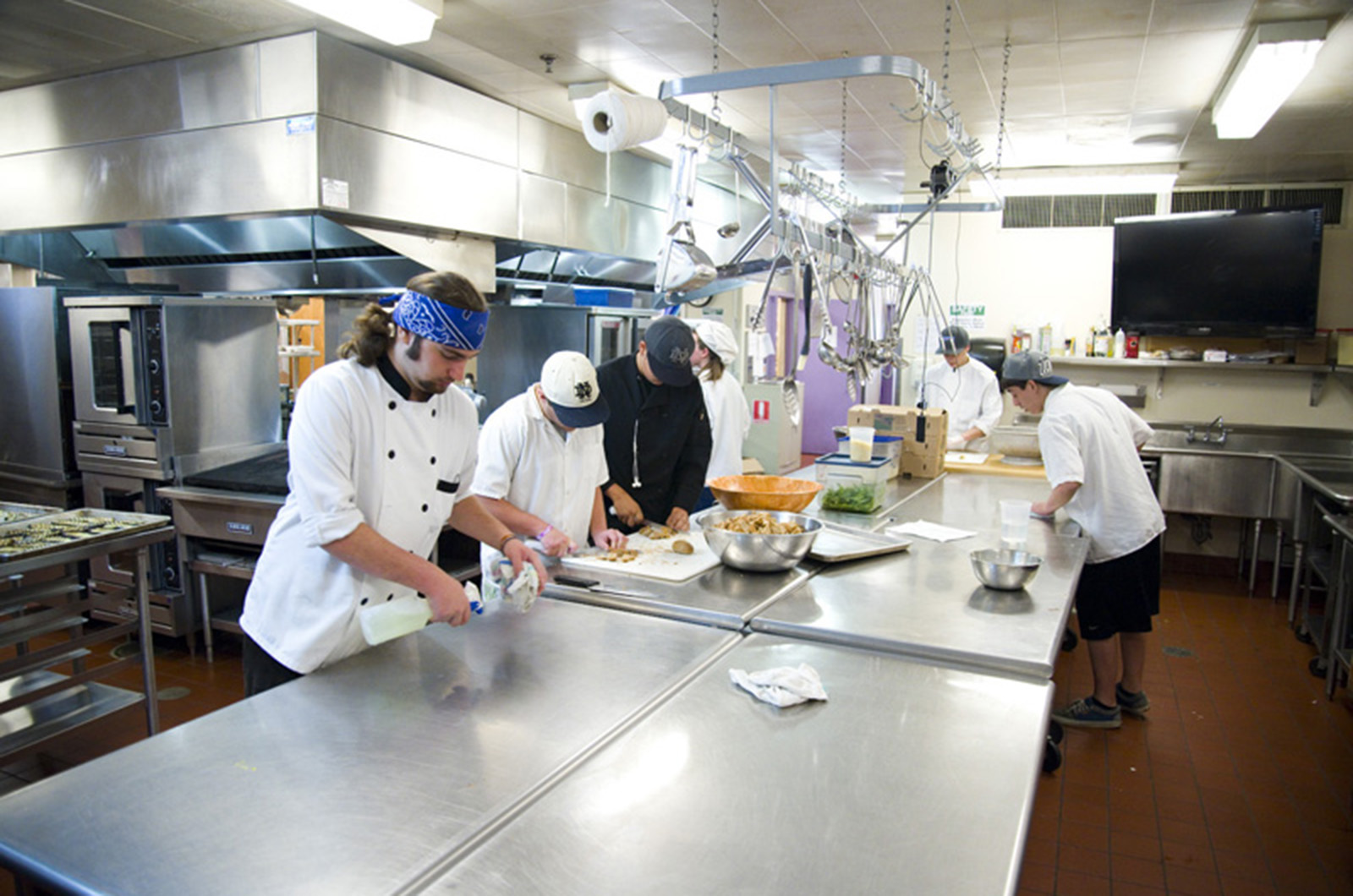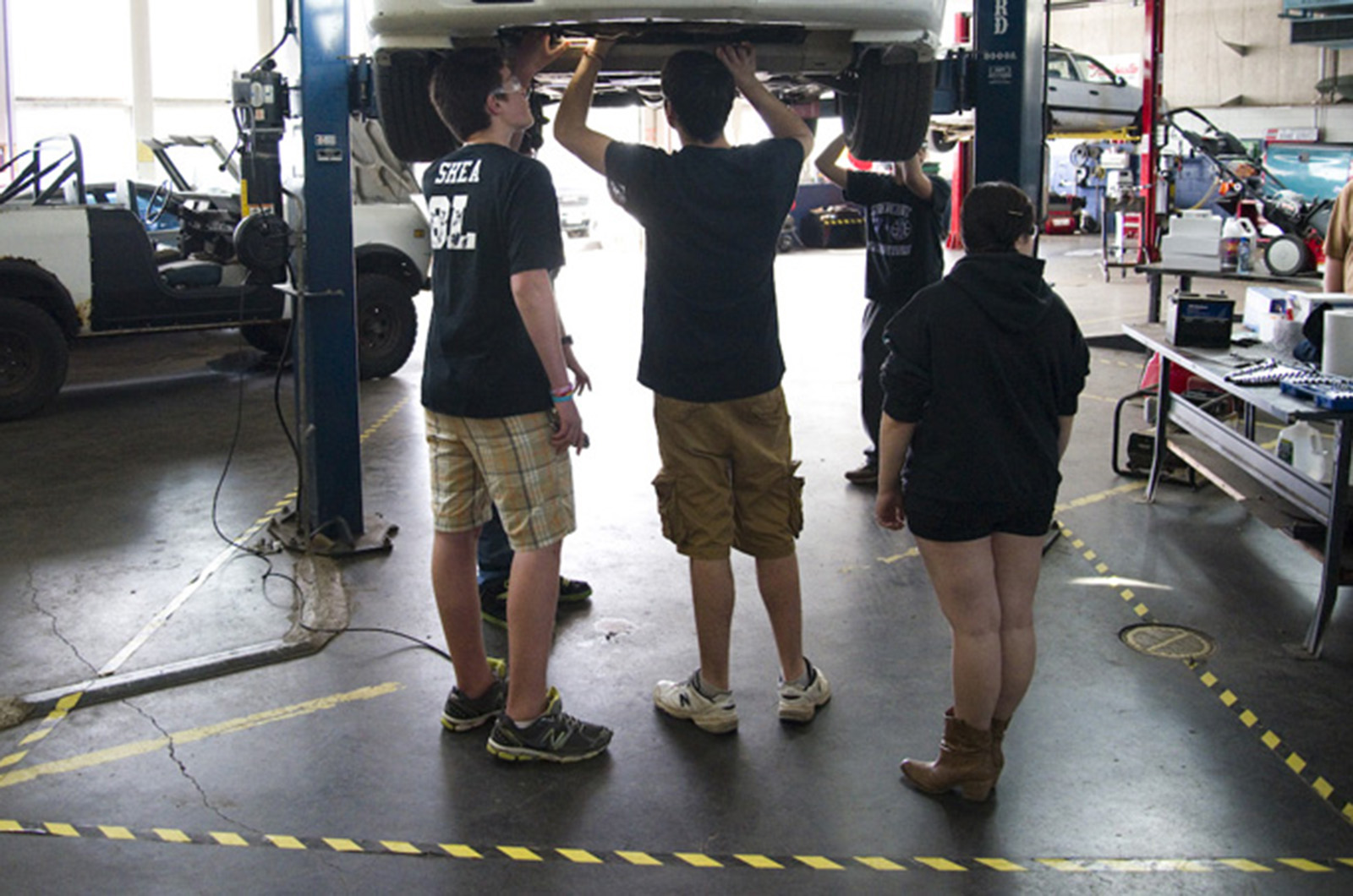It’s 7:30 a.m. Wednesday at the Martha’s Vineyard Regional High School, and the campus is alive with teenagers.
School buses have already dropped off close to 300 students, in plenty of time for the free hot breakfast served daily in the cafeteria. Hundreds of later arrivals stream through the school’s front doors, swapping greetings in English, Brazilian Portuguese and the universal language of sleepy smiles, nods and waves.
After the final bell rings at 7:45 a.m., most of the students have dispersed into classrooms, labs and studios. Others are starting their day in career-focused workshops like the culinary arts kitchen.
“What’s unique about our school is that we serve so many different groups of kids,” director of counseling John Fiorito told the Gazette during a round table interview with several department heads in principal Sara Dingledy’s office Tuesday.

More than 730 students are enrolled at the Island high school this year, representing a wide variety of backgrounds and educational needs.
Some are descendents of the Island’s first people, or of settlers who came here from England in the 1600s, or of Portuguese and Cape Verdean mariners, boat builders and farmers. Others are newcomers from Brazil who arrived this fall speaking barely a word of English.
With a student population expected to reach 805 over the next 10 years or so and a patched-together building that dates to the 1960s, school and community leaders are pursuing a state-supported building project that could cost more than $400 million. Public discussion about early-concept building plans has just begun.
The annual school census, held earlier this month, put the number of MVRHS students at 734, a slight dip from the 751 counted in the annual student census a year ago.
But that total captures just one day in a constantly-changing environment: The high school continues to enroll new students, many of them newly arrived from Brazil with very limited English, Mr. Fiorito said.
“This year, we were averaging about two new enrollments [of Brazilian students] per week for the first . . . eight weeks,” he said.
The school gains about 15 to 20 Brazilian students a year, Mr. Fiorito and Ms. Dingledy said, apart from 2021-2022 when 52 new students arrived from Brazil.
“Because the borders were closed for a year with Covid, we had two years of growth in one year,” Ms. Dingledy said.
Statistics from the Massachusetts Department of Elementary and Secondary Education show that in the spring of this year, nearly 64 per cent of students at the high school were white and more than 26 per cent Hispanic, a catch-all term for Latin American cultures.
The state identified 4.3 per cent of students as “multi-race, non-Hispanic,” 4 per cent as African American, 1.5 per cent as Native American and fewer than .5 per cent Asian.
More than 29 per cent of students last spring spoke a language other than English at home, which director of English language learning Leah Palmer told the Gazette is in line with town elementary school numbers.
Islandwide, Ms. Palmer said, 30 per cent of public school children speak Portuguese at home.
About 15 per cent of last year’s high school students were classified as English learners.
While the language minority is largely Portuguese-speaking Brazilian, the high school also has students from other South American countries and from Jamaica.
The changing student body has led to changes in the school’s staff, which now includes two teachers from Brazil, one from Argentina and multiple staffers who are bilingual in English and Brazilian Portuguese.
Some students also are learning to interpret English for Brazilians, with 15 people passing the elective class last year, Ms. Dingledy said.
“That is a nice pathway for students to graduate with a certificate that they can be a community interpreter,” she said.
Students come from varying economic backgrounds, according to the state, which defined 36.6 per cent of last year’s high school population as low-income.
And along with its cultural and economic diversity, the high school educates students who, if this were a mainland district, likely would attend separate programs for special education or vocational training.
“By and large, all of our special education students are served right here,” said Barbara Bianco, the school’s head of special education.
Nearly 20 per cent of students at the high school are classified by the state as having disabilities, which can range from executive function disorders to developmental disabilities like autism.
Career and technical education on the Island also is consolidated under one roof at the high school, one of a handful in Massachusetts that is both an academic school focused on college prep and educational achievement, as well as a vocational school geared toward technical careers.
The school has six state-approved career and technical programs: carpentry, automotive, horticulture, culinary arts, health assisting and early education and care.
The proposed new or remodeled high school would include specialized laboratories for the technical programs, most of which currently are shoehorned into inadequate spaces.
Regardless of what happens with the building project, Ms. Dingledy said the school expects to continue offering elective career and technical training beginning in 10th grade.
Students aiming for academic excellence also figure prominently at the high school, which offers more than 20 Advanced Placement courses and dual enrollment with Middlesex Community College for classes in English and statistics.
“It allows them to get 12 credits without having to pay, because many of these are students that are either taking upon themselves to pay for college or [seeking] state funding to pay for college,” Ms. Dingledy said of the community college partnership.
About 70 per cent of graduates go on to four-year colleges, Ms. Dingledy said, compared to a rate of some 95 per cent for many all-academic high schools in mainland suburbs.
“We’re actually proud of the fact that we don’t send 95 per cent of the kids [to college], because I think the trades are valued on Martha’s Vineyard,” she said.
“The hard part is, we also don’t have a large or a substantial group of kids going to two-year colleges ... or trade programs, for, I think, historic reasons,” Ms. Dingledy continued.
“We’re surrounded by open ocean. To get to Cape Cod Community College to do a two-year program is as daunting a task for a student as it is to go to Bridgewater State, because they’re either living in Hyannis or they’re commuting,” she said.
Mr. Fiorito said educators are working to bridge that gap with ACE MV, the Island’s continuing education nonprofit, which is bringing more college courses and technical courses to the high school.
“The one good thing about Covid, it has broken down the old-school way of how people teach, even trade schools or community college,” he said. “You can be a Cape Cod Community College student now and never leave the Island. That is a huge opportunity for our kids [and] trade schools are doing the same thing.”
In the end, Ms. Dingledy said it all adds up to a relatively unique student body.
“We have so many different profiles of students who want different things out of high school,” the principal said.
“Some students use our school as a landing pad to get onto the Island and get into the workforce and learn English. Some students use our school as a launching pad to Yale.”
Ideally, she said, success for the high school would be defined as “kids having a good time here and learning a lot here, not just creating a way station to somewhere else.”








Comments (6)
Comments
Comment policy »